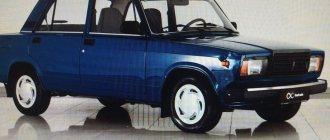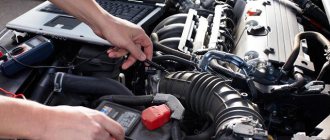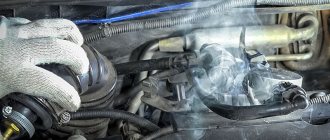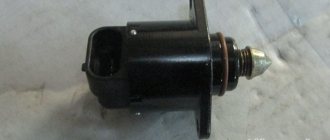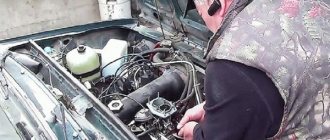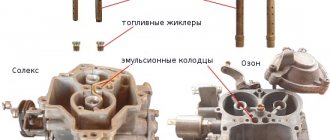Grow up everyone. And so, in this entry I would like to tell you how I got confused with the Solex 21083 carburetor. A lot has already been written about the Solex, a video has been shot and a very large number of solutions to certain problems. But perhaps I’ll repeat myself in my post. In this post I will try to tell you how I customized it for myself and my car. The recording is not a guide to action, since I am far from a carburetor specialist and two and a half years ago I only knew its approximate location under the hood. The goal was to optimize the work, namely, to make the idle times stable, to make stable work in transient modes, to achieve smooth dynamics over time, to improve performance in power modes. And so a little about the Solex 21083 device from Murzilka:
1. Carburetor heating unit 2. Throttle valve of the first chamber 3. Pipe for suction of crankcase gases 4. Accelerator pump drive lever 5. Accelerator pump drive cam 6. Accelerator pump diaphragm 7. Power mode economizer fuel nozzle 8. Pump housing 9. Economizer diaphragm power modes 10. Shut-off solenoid valve 11. Idle fuel jet 12. Carburetor cover 13. Main air jet of the first chamber 14. Air damper 15. Accelerator pump nozzles with fuel supply valve 16. Starter diaphragm 17. Starter adjustment screw 18. Adjusting screw for the amount of idle mixture 19. Locking lever of the second chamber 20. Pipe for supplying vacuum to the vacuum regulator of the ignition distributor 21. Adjusting screw for the quality of the idle mixture 22. Throttle valve control sector 23. Throttle valve drive lever 24. Adjusting screw for opening the throttle damper of the first chamber 25. Air damper control lever 26. Starter rod 27. Electrical wire of the limit switch of the forced idle economizer 28. Air damper lever 29. Main air jet of the second chamber 30. Emulsion tube 31. Sprayer of the main dosing system of the second chamber 32. Fuel supply pipe 33. Fuel drain pipe into the tank 34. Fuel filter 35. Needle valve 36. Second chamber throttle valve 37. Second chamber throttle lever 38. Second chamber main fuel jet 39. Second chamber throttle drive lever 40. Float
I would like to say that Solex was specially designed for cars with a transverse engine, specifically for the Samar family, and was also designed to operate the internal combustion engine on a lean mixture!
Cleaning.
All carburetors are cleaned only with a special liquid and then blown with compressed air. No brushes, rags or other crap. The holes in carburetors are sometimes very small in size, and a piece of thread that accidentally gets into the system can simply negate all cleaning efforts, and in rare cases, kill the carburetor.
So. I completely removed the carb from the intake manifold. I had difficulty getting the spacer out. Two rubber-metal ones and a heat-protective spacer. Everything is replaceable. The intake manifold was covered with a rag with processed edges (without threads or trash on the sides). Due to low mileage and high humidity, an emulsion got under the throttle from the breather, which led to a drop in idle speed at power modes. Actually, this was the reason for completely cleaning the carb and reconfiguring it. A push so to speak.
There are many different modifications of Solex carburetors, while the 21083 series is the basic version with a minimal diffuser cross-section. This model is usually installed on 1.5-liter engines of VAZ cars. We previously wrote about the “Ozone” setting on models 2106 and 2107.
The enormous popularity of this series is due to the possibility of grooving diffusers. Thus, almost any modification to the carburetor can be made. Experts do not recommend installing Solex on engines with a volume of more than 1.5 liters, as in this case the engine will be “choked” at high speeds. If you intend to configure this carburetor for the UZAM power unit, it is necessary to replace the jets due to the fact that a richer fuel mixture must be provided.
Possible problems when setting up XX
When the quantity screw is tightened, the engine does not react at all . This problem can occur when a large amount of fuel enters the idle diffuser. There may be several reasons for this:
- an XX jet of a larger size than necessary is installed;
- the plug or solenoid valve is not tightened properly, so gasoline is sucked in, bypassing the XX jet;
- The jet or its seat is deformed.
To identify the specific cause of the above problem, it is necessary to disconnect the wire from the valve while the engine is running, and the motor should immediately turn off. If this happens, most likely the wrong size XX jet is installed. When the engine does not stall when the power supply to the valve is turned off, it means that fuel is supplied bypassing the exhaust system, including the nozzle itself.
To eliminate the malfunction, first remove the plug or solenoid valve and check the condition of the nozzle and seat for any deformations. If the seat is damaged, you will have to replace the carburetor cover. If no damage or deformation is detected, put the jet on the solenoid valve and lubricate the o-ring with oil. Then we tighten the nozzle with a wrench, holding it with one finger without much effort.
Possible breakdowns of the second camera and their diagnosis
Malfunctions of the second chamber of a Solex carburetor or a unit from another manufacturer are not uncommon. To neutralize these, it is necessary to identify the exact cause of the breakdown, which means clearly answering the question - “Why doesn’t the second chamber of the carburetor work or does it do it completely incorrectly?” In fact, there may be many answers to this question, because the design of any carburetor is not very simple. In any case, all breakdowns can be “treated”, so let’s pay attention to ways to diagnose them.
You can familiarize yourself with all kinds of malfunctions in the following list:
- The carburetor chamber is flooded. Perhaps the most common cause of malfunction of this part of the assembly. It can manifest itself either as an independent breakdown or as part of a full-fledged problem when the carburetor begins to mercilessly “spill” fuel and richen the mixture. The unit often leaks gasoline due to contamination of the fuel channels, which is expressed in the appearance of typical symptoms of an enriched mixture: black smoke from the exhaust pipe, dips, lack of traction, fuel in the air filter, and so on;
- The clearance of the second carburetor chamber is set incorrectly. Everything here is extremely simple - the valve of the second chamber violates its normal position and cannot open as before, as a result of which the problem described above appears (the unit overflows gasoline or openly floods the cylinders with it);
- The damper doesn't bother to open at all. In such a combination of circumstances, as a rule, fuel overflows in the second chamber and the same symptoms of an overly enriched mixture begin. In this case, we first check the proper functioning of all throttle valve actuators; if they are normal, then the second chamber does not come off for other reasons;
- The proper amount of fuel does not flow into the second chamber of the carburetor. The symptoms in such a situation will be those that appear with a lean mixture. The motor suffers especially often, as it overheats greatly when operating at medium to high speeds. It is precisely when the second chamber of the unit should come into operation. The cause of this problem may be either clogged carburetor channels or incorrect settings;
- Specific components of the part necessary for stable operation of the second chamber have failed (forced XX economizer, diffuser, jets, etc.). If something like this happens, then the operation of the carburetor becomes extremely crumpled, unstable and, in general, incomprehensible, with the manifestation of either symptoms of enrichment of the mixture above the norm, or depletion. To organize repairs under such circumstances, you will have to carry out a comprehensive diagnostics of the unit.
How to choose jets?
The selection of jets for Solex 21083 is made taking into account the engine size. Experts recommend starting the selection with a fuel nozzle for the first chamber. Having selected the desired sample, we select the corresponding air analogue for it. And then in the same order we select the jets for the second chamber. First you need to look for a factory carburetor designed for the size of your engine, remove the jets from it and take them as a reference point. Further selection of jets is made according to this principle. If you need to lean the mixture a little, choose a larger jet by one pitch. If you want to enrich it, use a smaller jet.
Solex carburetor. Device
The Solex carburetor has two chambers with throttle valves to form an emulsion (a mixture of air with gasoline vapor), an idle system in one chamber, dosing systems, an accelerator pump, and an economizer.
Basic Solex carburetor systems:
- Economizer (jet system for increased power mode);
- Accelerator pump (when you sharply press the gas pedal, fuel is injected into the mixing chamber, sharply increasing the volume of the mixture);
- Semi-automatic starting device
The Solex carburetor is considered the best of all carburetors produced for passenger cars. It can be configured for any engine with a volume from 1.0 to 2.5 liters.
It works stably both on a lean and a very rich fuel mixture (overflow). Craftsmen can easily install it, but installation is not the most difficult thing. It is more difficult to configure it and optimally adjust it to all modes of engine operation.
Let's assume you have installed Solex, start setting it up.
Manufacturer and type of carburetors
Metering elements prepare a mixture of fuel and air, then help distribute it evenly throughout all cylinders of a car engine. Gasoline and air can be mixed in two different ways. Carburetors with a membrane-needle device have one operating principle, float carburetors have another. In the VAZ-2107 car it belongs to the second type of design.
The manufacturer of the mechanism is the DAAZ enterprise, or Dimitrovgrad Automotive Assembly Plant. Correct configuration and adjustment of the “seven” dosing systems is the most important means of ensuring long-term operation and maintaining the operating condition of the engine throughout its entire service life. To understand why the carburetor overflows, you need to understand how the mixture formation process is carried out.
IMPORTANT! Before starting the adjustment, it is necessary to establish exactly what type of device is used in the engine design. This will make it easier to determine why the carburetor is flooding. If it has a vacuum ignition corrector, it means the car is equipped with the latest model VAZ-2103 or VAZ-2106 engine. Carburetor modification 2107-1107010-20.
It may be that the “seven” has a six-wheel engine. In this case, the dosing system will not have a vacuum ignition corrector. A similar modification of the carburetor is 2107-1107010-10. These two designs differ slightly, but each model has its own subtleties of adjustment and tuning. Knowing them, you can understand the reason why the VAZ-2107 carburetor overflows.
Useful information for adjusting the DAAZ carburetor
Summary table of parameters of carburetors manufactured by DAAZ.
| Carburetor designation | VAZ engine | Mixture sprayer chamber I | Mixture sprayer II chamber | ||
| Designation | Marking | Designation | Marking | ||
| 2101-1107010-02 | 2101; 21011 | 2101-1107410 | 4,5 | 2101-1107410 | 4,5 |
| 2101-1107010-03 | 2101; 21011 | 2101-1107410-10 | 4,0 | 2101-1107410 | 4,5 |
| 2101-1107010-30 | 2101; 21011 | 2101-1107410-10 | 4,0 | 2101-1107410-10 | 4,0 |
| 2103-1107010 | 2103; 2106 | 2101-1107410 | 4,5 | 2101-1107410 | 4,5 |
| 2103-1107010-01; 2106-1107010 | 2103; 2106 | 2101-1107410-10 | 4,0 | 2101-1107410-10 | 4,0 |
| 2105-1107010-10 | 2101; 21011 | 2105-1107410 | 3,5* | 2101-1107410 | 4,5 |
| 2105-1107010; 2105-1107010-20 | 2101; 21011; 2105 | 2105-1107410 | 3,5* | 2101-1107410 | 4,5 |
| 2107-1107010; 2107-1107010-20 | 2103; 2106 | 2105-1107410 | 3,5* | 2107-1107410 | 4,5* |
| 2107-1107010-10 | 2103; 2106 | 2105-1107410 | 3,5* | 2107-1107410 | 4,5* |
| 2108-1107010 | 2108 | 2108-1107410 | 2108-1107410 | — | |
Marking of DAAZ carburetor jets (Table 1).
| Carburetor designation | Econostat jet | Pneumatic drive jet | Starter damping jet | Throttle opening at startup (dimension A), mm | Slight opening of the air damper with the starting device (size B), mm | Fuel level in the float chamber, mm | |||
| 2101-1107010 | 150 | 90 | 170 | — | — | 70 | 0,75-0,85 | 7±0,25 | 7±0,25 |
| 2101-1107010-02 | 150 | 90 | 170 | — | — | 70 | 0,75-0,85 | 7±0,25 | 7±0,25 |
| 2101-1107010-03; 2101-1107010-30 | 150 | 120 | 150 | — | — | 70 | 0,75-0,85 | 7±0,25 | 6,5±0,25 |
| 2103-1107010 | 180 | 120 | 160 | — | — | 70 | 0,8-0,9 | 7±0,25 | 7±0,25 |
| 2103-1107010-01; 2106-1107010 | — | — | — | — | — | 70 | 0,8-0,9 | 7±0,25 | 6,5±0,25 |
| 2105-1107010-10 | 150 | 120 | 150 | 120 | 100 | 70 | 0,7-0,8 | 5±0,5 | 6,5±0,25 |
| 2105-1107010; 2105-1107010-20 | 150 | 120 | 150 | 120 | 100 | 70 | 0,5-0,8 | 5±0,5 | 6,5±0,25 |
| 2107-1107010; 2107-1107010-20 | 150 | 120 | 150 | 150 | 120 | 70 | 0,9-1,0 | 5,5±0,25 | 6,5±0,25 |
| 2107-1107010-10 | 150 | 120 | 150 | 150 | 120 | 70 | 0,9-1,0 | 5,5±0,25 | 6,5±0,25 |
| 2108-1107010 | 60 | — | — | — | — | — | 0,85 | 3±0.2 (bottom) | 25.5±1.0 (remainder) |
Marking of DAAZ carburetor jets (Table 2).
| Carburetor designation | Fuel main system | Air main system | Fuel idle | Air idle | The jet will speed up. pump | |||||
| I Kam. | II Kam. | I Kam. | II Kam. | I Kam. | II Kam. | I Kam. | II Kam. | fuel | bypass | |
| 2101-1107010 | 135 | 135 | 170 | 190 | 45 | 60 | 180 | 70 | 40 | 40 |
| 2101-1107010-02 | 130 | 130 | 150 | 190 | 50 | 45 | 170 | 170 | 40 | 40 |
| 2101-1107010-03; 2101-1107010-30 | 130 | 130 | 150 | 200 | 45 | 60 | 170 | 70 | 40 | 40 |
| 2103-1107010 | 135 | 140 | 170 | 190 | 50 | 80 | 170 | 70 | 50 | 40 |
| 2103-1107010-01; 2106-1107010 | 130 | 140 | 150 | 150 | 45 | 60 | 170 | 70 | 40 | 40 |
| 2105-1107010-10 | 109 | 162 | 170 | 170 | 50 | 60 | 170 | 70 | 40 | 40 |
| 2105-1107010; 2105-1107010; 2105-1107010-20 | 107 | 162 | 170 | 170 | 50 | 60 | 170 | 70 | 40 | 40 |
| 2107-1107010; 2107-1107010-20 | 112 | 150 | 150 | 150 | 50 | 60 | 170 | 70 | 40 | 40 |
| 2107-1107010-10 | 125 | 150 | 190 | 150 | 50 | 60 | 170 | 70 | 40 | 40 |
| 2108-1107010 | 97,5 | 97,5 | 165 | 125 | 42±3 | 50 | 170 | 120 | 35/40 | — |
↑
The most common causes, methods of elimination
NOTE! When the 2107 Ozone carburetor is overfilled, you must first check the adjustments and settings of the first and second float chambers.
Defective or leaking needle valve
The most common reason when the needle valve is stuck open is that fuel is overflowing the carburetor. What to do in such a situation?
IMPORTANT! Sticking can be eliminated by tapping the lid lightly with a hammer. At the same time, it is necessary to check the tightness of the closure of the valve with the needle, whether there is a rubber O-ring under it. Apply vacuum to the valve to check operation.
Broken or leaky float
If the carburetor overflows, the float drowns in gasoline, dragging the shut-off valve needle with it. In this situation, the needle valve is constantly open. Gasoline is pumped into the float chamber without any obstacles. It is not difficult to detect a leaky float. Remove it from its regular place, shake it near your ear to see whether gasoline splashes inside or not. You can solder it, but it is better to immediately replace it with a new one.
The float touches the walls of the float chamber
IMPORTANT! When the carburetor on a VAZ-2107 floods, it means that its position relative to the walls of the float chamber is disturbed. In order to eliminate the breakdown, it is necessary to remove the cover and inspect the position of the float relative to the imprint on the cardboard spacer. It must be parallel. At the same time, the ease of movement around the chamber, skew, deformation of the racks and levers are checked.
Excessive gasoline level in the float chamber
If the VAZ 2107 carburetor overflows, you need to remove the cover and check the fuel level in the float chamber. It should be in the middle of the inclined plane of the front wall of the float chamber. The distance to its bottom is 29±2 mm.
In the figure above, the recommended fuel level is marked with a red line. If the carburetor on a VAZ-2107 car is flooded, it is necessary to bend the float tongues so that the level is established at this mark.

